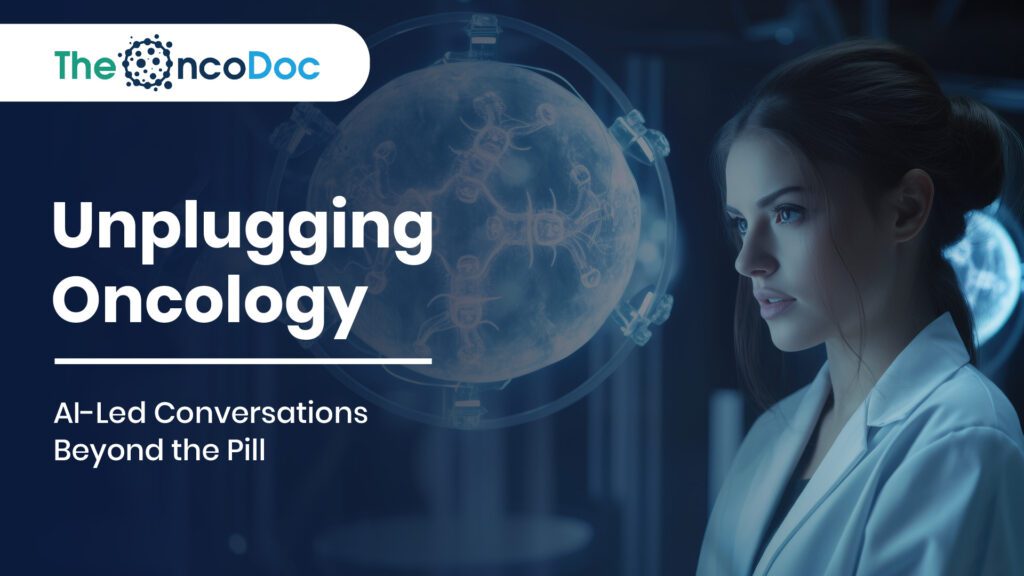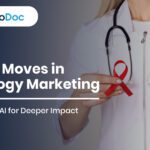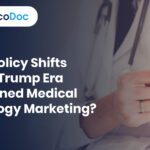Introduction: Where Compassion Meets Smart Marketing
By 2025, marketing for oncology pharmaceuticals will focus on visionary effect rather than just visibility. The convergence of artificial intelligence (AI), patient-centricity, and real-world data has led to an industry reset where precision, personalization, and proactivity shape every marketing move. With cancer care becoming increasingly complex, the pharmaceutical industry is adopting smarter, AI-driven methods to not only communicate but also co-create value with physicians, patients, and policymakers.
Gone are the days of mass promotion and generic educational drives. Today, oncology brands are expected to act as data partners, digital enablers, and emotional allies. In this article, we explore how cutting-edge technologies and human empathy are redefining oncology pharma marketing, across campaign design, content personalization, healthcare professional (HCP) engagement, and outcome measurement.
1. AI as the Architect of Personalized Patient Pathways
AI is transforming oncology marketing from reactive messaging into predictive, patient-centric engagement. No longer limited to automation, AI now plays a strategic role in designing individualized cancer care journeys, from early symptom awareness to post-treatment support. Pharma marketers are leveraging machine learning to understand patient behaviors, anticipate needs, and deliver timely, relevant interventions.
Key capabilities include:
- Analyzing search behavior patterns (e.g., “persistent fatigue,” “lump in breast”), wearables, and app usage to detect early warning signs.
- Predicting care-seeking moments and triggering preemptive digital content like localized screening information, interactive symptom checkers, or emotional survivor stories.
- Mapping each step of the patient’s decision-making process and customizing educational tools accordingly.
This hyper-personalized approach delivers measurable results:
- Brands adopting AI-driven pathways have seen a 45% increase in click-through rates.
- Screening participation among target audiences has improved by over 30% in predictive content-driven campaigns.
By acting as a digital health guide, AI empowers patients to take earlier, informed steps in their journey, ultimately improving outcomes while building meaningful trust in pharma-led communication.
2. Reimagining Segmentation: From Demographics to Dynamic Behavior
Audiences for oncology are dynamic groups that are changing both emotionally and behaviorally. AI tools now enable real-time segmentation based on how people consume, interact with, and respond to cancer-related content.
This granular segmentation allows pharma marketers to match not only the message but also the format, tone, and channel. A busy oncologist on rounds might prefer a 30-second voice note summarizing new trial results, while a researcher may prefer a downloadable whitepaper with deep RWE analytics.
3. From HCP Education to Intelligent Enablement
With oncology evolving at breakneck speed, general practitioners and even specialists struggle to stay updated. Pharma marketers are stepping in as knowledge providers, offering AI-powered dashboards that serve up region-specific alerts, new therapy summaries, and diagnostic guidelines based on the user’s specialization.
Instead of blanket CME programs, companies are now delivering personalized micro-learning modules via WhatsApp, LinkedIn, and proprietary HCP apps. These tools include:
- AI-curated patient referral prompts
- Contextual drug trial summaries
- Quick diagnostic aids for rare tumor types
This shift from push-marketing to enablement builds not just brand visibility, but clinical trust.
4. Predictive Campaigns for Preventive Oncology
Imagine identifying a cancer outbreak zone before it appears in hospital records. That’s now possible with AI’s predictive models that track search spikes, wearable health deviations, and community-level data.
For instance, early oral cancer awareness efforts may be prompted by a rapid increase in “mouth ulcers” and “swollen glands” in a rural community.
. AI models assess:
- Local search trends
- Past oncology drug demand in the area
- ASHA worker visit reports
- Patient walk-ins at partner diagnostics
By using these inputs, pharma companies can deploy hyperlocal, time-sensitive campaigns that bring screening to high-risk zones before the problem scales. This shift, from reactive to preemptive marketing, makes the brand a health ally rather than just a medication provider.
5. Emotion-Driven Content and Survivor Storytelling
In oncology marketing, data and facts build awareness, but it’s emotion that inspires action. AI-based insights from campaign performance reveal that content rooted in personal stories drives deeper engagement, with survivor-led narratives achieving twice the retention and 40% higher shareability compared to clinical data alone.
Pharma brands are increasingly embracing emotion-centric storytelling formats to foster trust, relatability, and urgency. These include:
- Short-form video series documenting a patient’s journey from symptoms to survival
- Podcast-style interviews with cancer survivors and their caregivers sharing real-life experiences
- Oncologist testimonials reflecting on challenging cases and the emotional side of care
These stories are disseminated through platforms like Instagram Reels, YouTube Shorts, and regional audio channels, ensuring they’re not only impactful but accessible. Shared in local languages and cultural contexts, they resonate more deeply with underserved populations.
By humanizing the cancer journey, this content doesn’t just inform, it motivates real behavioral change, such as booking a screening, consulting a physician, or supporting a loved one. Emotionally intelligent marketing, backed by AI analytics, is emerging as a powerful tool in closing the gap between awareness and action in cancer care.
6. Vernacular & Hyperlocal Customization: From Awareness to Access
Cancer literacy varies widely across geographies. A one-size-fits-all awareness message fails to resonate with India’s deeply localized communities. The new playbook emphasizes:
- State-language video content (e.g., Kannada for cervical cancer in Karnataka)
- Cultural forms (community theater in Maharashtra, folk music in Odisha)
- Geo-targeted SMS reminders about local screening events
Rural campaign involvement has increased by 50–60% as a result of this localization. Companies that “speak the language of the land” are more likely to gain the confidence of customers.
7. Real-Time Sentiment Tracking and Agile Optimization
AI-powered sentiment analysis is revolutionizing how oncology marketers monitor emotional responses and adapt campaigns in real time. Rather than relying solely on post-campaign reports, brands can now detect audience sentiment as it unfolds, allowing for immediate action.
For instance, if an AI engine detects rising use of emotionally charged keywords in chatbot interactions, such as “anxious,” “helpless,” or “expensive”, it can automatically recommend empathetic content, like financial guidance videos or mental health support stories. Likewise, if a campaign post receives comments expressing confusion or mistrust (e.g., “Is this legit?”), the system flags it, prompting the brand to release clarifying explainer content or a trusted KOL video that same day.
This continuous feedback loop enables marketers to:
- Refine messaging tone and format based on real-time emotional cues
- Adapt visual and verbal content for better clarity and reassurance
- Update CTAs to align with the user’s current emotional state or concern
Real-time optimization transforms campaigns into emotionally aware communication ecosystems, improving not only engagement but trust and response rates. In oncology, where empathy matters as much as accuracy, this capability ensures that brands stay relevant, responsive, and human-centered at every moment.
8. Chatbots as 24/7 Patient Concierges
In the era of AI-powered engagement, chatbots have evolved into round-the-clock digital health companions, bridging the gap between information and action for oncology patients and caregivers. No longer limited to passive FAQ tools, modern pharma chatbots on platforms like WhatsApp and Telegram deliver real-time, interactive support tailored to each user’s needs.
Key functionalities now include:
- Symptom assessment via conversational Q&As, helping users identify potential warning signs
- Location-based recommendations for nearby diagnostic centers or screening camps
- Verified contact details for oncologists and support services
- Educational videos and content in local languages, improving accessibility and understanding
These bots are unique because of their capacity for learning and adaptation. With each interaction, they refine responses based on prior questions, language preferences, and emotional tone, offering increasingly personalized guidance over time. The impact is significant: pharma chatbots have demonstrated a 3.4x higher conversion rate to screening sign-ups compared to static web forms. By offering instant, intelligent, and culturally sensitive assistance, these digital concierges empower users to take action confidently and conveniently, transforming passive interest into life-saving steps.
9. Post-Treatment Engagement and Holistic Support
The end of cancer treatment marks the start of a new phase, survivorship, which comes with its own set of emotional, physical, and lifestyle challenges. Leading pharma brands are now extending their role beyond treatment by offering sustained, holistic support that empowers patients long after hospital visits end.
Key post-treatment support solutions include:
- Digital recovery apps that help track fatigue, side effects, emotional health, and sleep quality in real time
- Nutrition and wellness platforms, linked to oncologist dashboards, providing personalized dietary plans to support recovery
- Virtual survivor communities that host interactive sessions with cancer survivors, offering peer advice and encouragement
This ongoing engagement model not only supports better health outcomes, but also encourages adherence to follow-up care and regular check-ins, both crucial to preventing relapse or complications.
By continuing to show up in the patient’s life after treatment, pharma companies build deeper trust and brand loyalty, evolving from product providers to partners in survivorship. These efforts demonstrate a commitment to long-term well-being, ensuring patients feel supported, heard, and empowered at every stage of their recovery journey.
10. Social Listening to Tackle Misinformation
In today’s digital-first world, misinformation spreads rapidly, especially in sensitive areas like cancer care. AI-powered social listening tools have become essential for identifying and addressing health-related myths in real time. These technologies monitor open forums, comment sections, and even encrypted community channels like WhatsApp and Telegram to detect early signals of harmful content.
Key misinformation types flagged by AI include:
- Unverified home remedies claiming to cure cancer
- False narratives about clinical trials and drug safety
- Panic sparked locally by out-of-date facts or viral fake news
Once identified, pharma teams act quickly by deploying evidence-based counter-messaging, such as:
- Short videos featuring certified oncologists debunking viral myths
- Infographics in local languages clarifying facts versus fiction
- Interactive Q&As or myth-busting posts across social media
These interventions help position pharma brands as credible voices of science and support. Rather than reacting passively, companies become proactive protectors of public health literacy. This not only safeguards patient trust but also builds digital goodwill and long-term brand equity, especially in underserved or misinformation-prone communities. By embracing social listening, pharma shifts from advertiser to community health ally, a role that’s more vital than ever.
11. The KPI Reset: Measuring Real Health Impact
Clicks and impressions are no longer enough. Oncology brands now track metrics that reflect real-world impact:
This focus on health behavior outcomes shifts pharma marketing from commercial to clinical success indicators.
12. Future of Oncology Pharma Marketing: Digital Twins, AR, and Beyond
Looking ahead, the industry is preparing for radical transformation through:
➤ Digital Twins
These AI-created virtual patient profiles simulate disease progression, helping marketers predict treatment responses and tailor campaigns.
➤ Augmented Reality for Training
AR is being used to simulate tumor growth, drug interaction, and surgical procedures, offering immersive education for HCPs in Tier 2/3 cities.
➤ Emotion AI
In the near future, emotion AI systems will analyze campaign viewers’ facial expressions and automatically adjust videos to heighten urgency or empathy as necessary.
Conclusion: From Outreach to Impactful Collaboration
In 2025, oncology pharma marketing has evolved into a mission-driven effort that goes far beyond promotion. It’s now centered on co-creating value-based, patient-first experiences that begin before diagnosis and extend well into survivorship. The goal is not simply to inform, but to enable timely detection, enhance treatment outcomes, and provide holistic support across the cancer care continuum. Here, AI acts as a strategic enabler, bringing precision, scale, and personalization to every step of the journey.
Leading pharma brands are embracing this shift by blending technology, empathy, and real-world data to build meaningful engagement. Today’s campaigns are no longer one-sided, they are collaborative, culturally sensitive, and deeply personalized. It’s about creating shared value with healthcare professionals, caregivers, and patients through experiences that resonate and respond in real time.
In this redefined landscape, every message becomes an opportunity for meaningful health action. Whether it sparks a screening, clarifies a diagnosis, or provides emotional reassurance, marketing is now a core driver of care. The future belongs to those who embrace AI not just as a tool, but as a partner in compassion, shaping oncology engagement that heals, empowers, and truly makes a difference.
The Oncodoc team is a group of passionate healthcare and marketing professionals dedicated to delivering accurate, engaging, and impactful content. With expertise across medical research, digital strategy, and clinical communication, the team focuses on empowering healthcare professionals and patients alike. Through evidence-based insights and innovative storytelling, Hidoc aims to bridge the gap between medicine and digital engagement, promoting wellness and informed decision-making.



